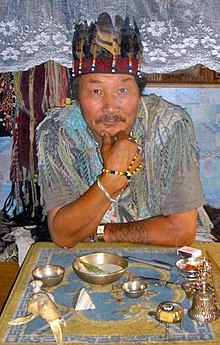Altaic shamanism

The Altaic shamanism or -Animismus is the oldest ethnic religion of the Turkic peoples of the Altai -Gebirges. Together with the animistic religions of the Mongols (→ Mongolian shamanism ) , the Tungus peoples and the other small Siberian peoples, it belongs to the classic Siberian shamanism / animism . The polytheistic religion of Tengrism emerged from Altaic shamanism . The demarcation is difficult.
In addition to the typical shamanistic properties, Altaic shamanism is characterized by a pronounced ancestral cult and a multitude of god-like mythical spirits .
Identity Features
Features of this religion are similar to other animistic religions of Siberia, as well as East Asia . There are parallels to shamanism in Korea and Japan . Altaic shamanism, as a typical animistic religion, has only a few clearly defined concepts of religious ethics . There are no written commandments that are valid for all believers or even all people at all times. However, some general tendencies are generally attributed to ethical practice in Central Asian thought:
- A lifestyle is advocated in harmony with nature, the spirits and gods (Tengers) as well as the ancestors, which can express itself in gratitude and help.
- The mythical beings are considered to be much “more mature” than humans, but not perfect in an absolute sense, such as in monotheism . Gods commit mistakes and even sins. Corresponding to this, there are no moral absolutes in Altaic shamanism.
- Due to ancestor worship, a deceased person - or an animal - can achieve the status of a god-like being. So there are different holy ancestors and spiritual beings from people to people who are worshiped.
Shamans
The shaman ( kam ) is not considered a holy person. He is only respected because he is associated with the spirits. In this respect it differs from the institution of a priest in institutionalized religions. No shaman is required to honor the Tengers and the spirits. The shaman's duties are mostly to maintain or restore the balance of power and to heal diseases. There are shamans of different strengths. Depending on what helping spirits they have, they have different abilities. A distinction is made between “white” (healing) and “black” (suffering) shamans.
Today's distribution
Altaic shamanism is a central part of Tengrism. Some Turkic peoples - especially in parts of Kazakhstan , Kyrgyzstan and Siberia - are still followers of shamanism since the collapse of the Soviet Union a ritual revitalization experienced.
There are a number of groups and organizations that promote Altaic animism and declare it to be the only true main religion of the Turkic peoples. The Kyrgyz activist Kubanychbek Tezekbaev explains, for example, that he has no problem with other religions and that he only wants to preserve the religious heritage of the ancient Turkic peoples. However, critics, mainly imams , claim that he wants to replace Islam with polytheistic animism and stir up religious hatred.
Individual evidence
- ↑ The Ancient Religion of Tengriism . In: Discover Mongolia Travel Guide - Travel to Mongolia . ( discovermongolia.mn [accessed November 20, 2018]).